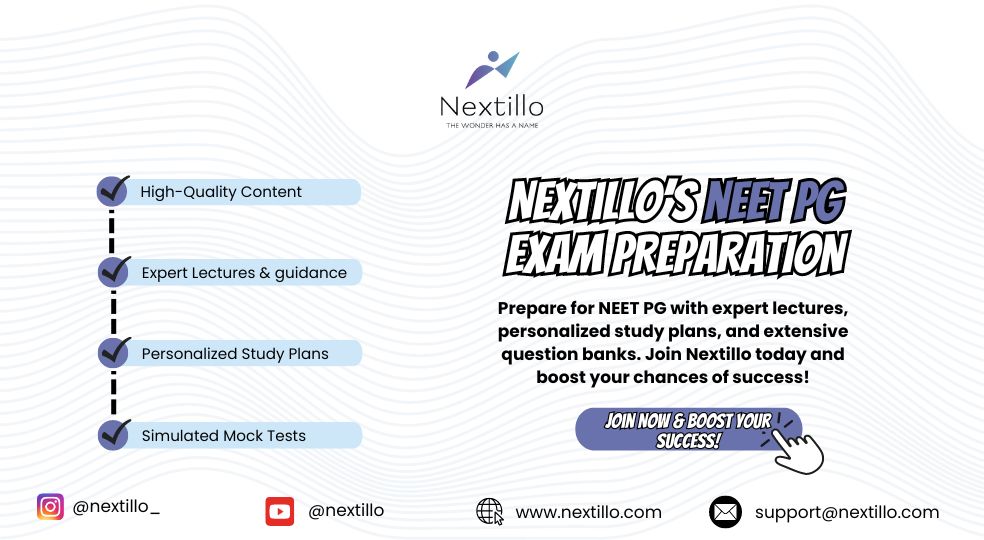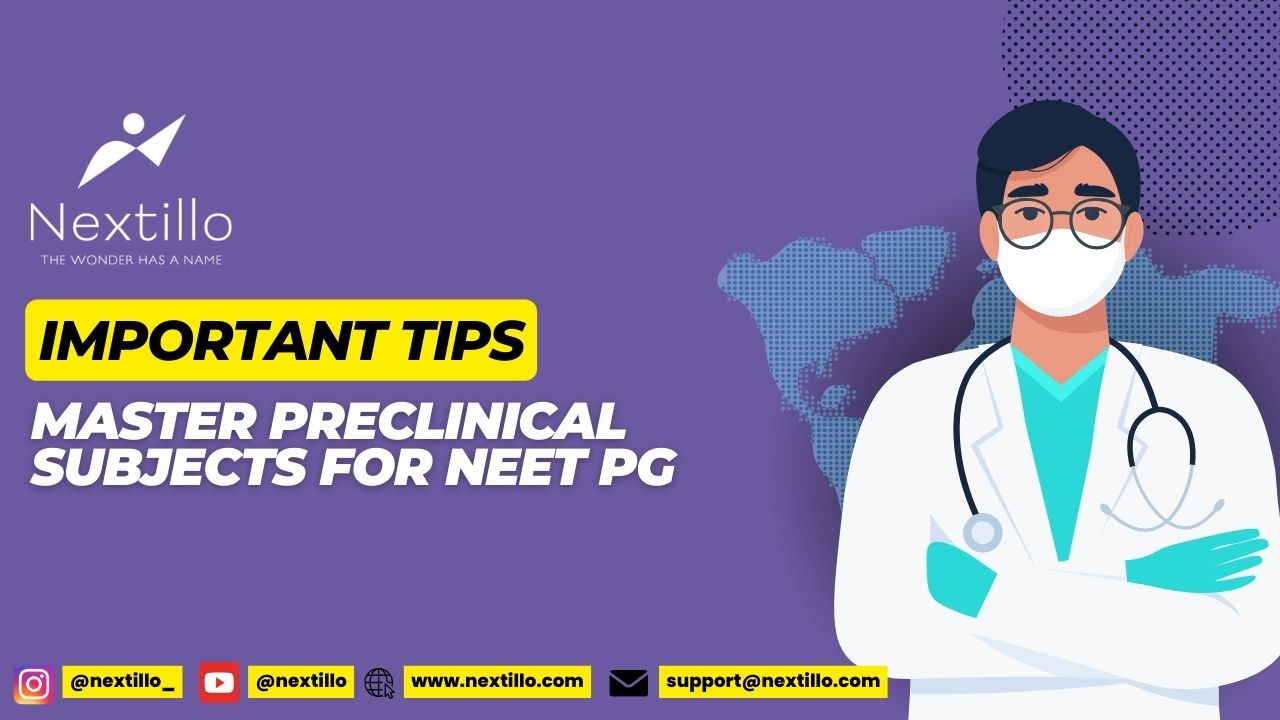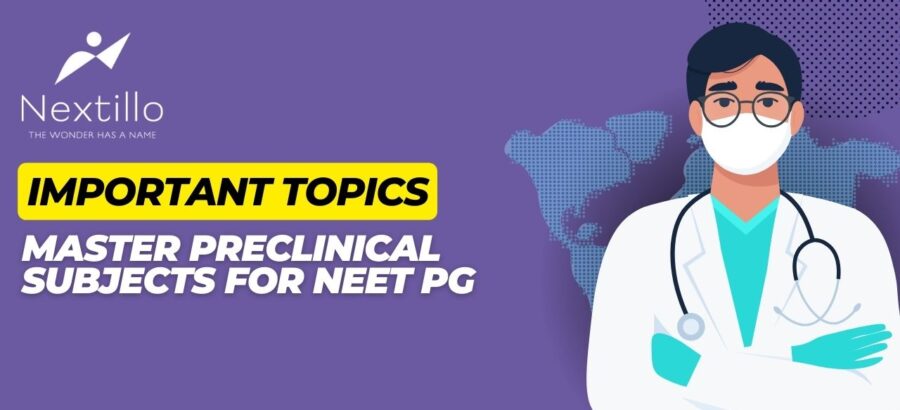It can be challenging for many of us to prepare for the NEET PG exam because of the vast syllabus Nextillo’s guide provides you with essential topics to prepare pre-clinical subjects for NEET PG that are crucial for the exam. Understanding these topics will give you a strong foundation and make your preparation easier.
Concentrate on these high-yield topics for NEET PG and be well prepared to handle the most challenging parts of the NEET PG exam with confidence.
Important Topics of Anatomy for NEET PG
List of high yield and most important topics from anatomy for the NEET PG exam
| Subject | High Yield Topics from Anatomy |
| Embryology | Derivatives of various germ layers, especially neural crest; Branchial arch and cleft derivatives; Spermatogenesis and oogenesis, including mitosis and meiosis |
| Histology | Types of epithelial linings in different regions |
| Osteology | Types of joints with examples; Ossification centers, especially those present at birth; Knee joint ligaments (study with orthopedics for injuries) |
| Neuroanatomy | Boundaries and structures of the cavernous sinus, including tributaries; Blood supply to the brain; Cross-sections of the brainstem; Boundaries of brain ventricles |
| Cranial Nerves | Cranial nerves and their nuclei, with a focus on the optic nerve pathway (important for INICET) |
| Upper and Lower Limbs | Brachial plexus: branches and common palsies; Root values and dermatomes of upper and lower limbs |
| Perineum | Anatomy and nerve supply of the urethra (including urethral trauma); Anatomy of the rectum and anal canal Contents of the spermatic cord; Derivatives of the reproductive system (linked with embryology) |
| Thorax | Arterial anatomy of the heart; Development and anatomy of the diaphragm; Bronchovascular segments of the lung; Structure of the lung hilum |
| Vascular Anatomy | Arteries and their branches: subclavian artery, axillary artery, internal iliac artery |
| Nerve Supply | Nerve supply to the perineum, ear, and eye |
| Anatomical Relations | Relations of the lesser sac and parotid gland; Detailed peritoneal anatomy |
Important Topics of Physiology for NEET PG
List of High-Yield and Most Important Topics from Physiology for the NEET PG Exam:
| Subject | High-Yield Topics from Physiology |
| General Physiology | Body fluid compartments; Cell membrane composition; Transport processes |
| Nerve and Muscle | Classification of nerve fibers; Sarcomere structure and changes during contraction; Energy systems in muscle |
| Cardiovascular System | Conducting system of the heart; Cardiac cycle (events, JVP, PV loops); ECG interpretation; Cardiac output and its calculation; Blood pressure measurement and regulation (including baroreceptors); Regional circulations (coronary, capillary) |
| Respiratory System | Mechanics of breathing (surfactant, lung compliance, lung volumes and capacities, dead space); V/Q ratio; Gas transport (oxygen); Regulation of breathing (respiratory center, chemoreceptors); Hypoxia |
| Renal System | Juxtaglomerular apparatus; Glomerular filtration rate (Starling’s forces); Tubular functions; Formation of concentrated urine; Micturition reflex; Acid-base balance (buffer systems) |
| Gastrointestinal System | Structure (ENS, BER, reflexes); GI motility; Secretions (saliva, gastric juice, pancreatic juice, bile); GI hormones |
| Endocrine and Reproduction | Pituitary gland; Thyroid gland; Adrenal cortex; Pancreas (hormones and disorders); Estrogen and testosterone; Ovulation |
| Central Nervous System | Synapse and neurotransmitters; Sensory system (receptors, ascending tracts, pain pathways); Motor system (descending tracts, cerebellum, basal ganglia, LMN, muscle spindle); Higher functions (hypothalamus, sleep, and EEG patterns, hemispheres, learning, and memory) |
| Special Senses | Visual pathway and processes; Organ of Corti |
| Environmental Physiology | Temperature regulation (heat and cold exposure); High and low barometric pressures; Energy balance |
| Muscle Physiology | Muscle spindle and Golgi tendon organs; Basic diagrams and components of the sarcomere; Proteins in A and I sub-units; Recruitment and DC coupling |
| Applied Physiology | Cardiac physiology (cardiac cycle changes, ECG, JVP); Reflexes (Brain Bridge, baroreceptor, Herring Breuer, Bezold Jarish, Cushing, Vasomotor Centre); Pulmonary function tests and MEFR curves; Stewart-Hamilton law and exercise physiology; Oxyhemoglobin dissociation curve and BP measurement; Renal physiology (GFR calculation, counter-current mechanism) |
Important Topics of Biochemistry for NEET PG
List of high yield and most important topics from Biochemistry for the NEET PG exam:
| Subject | High Yield Topics from Biochemistry |
| Carbohydrate Metabolism | Structural isomerism in carbohydrates; Mucopolysaccharides & related disorders; Glycolysis; TCA cycle; glucoseogenesis; ETC uncouplers; HMP pathway; Galactose metabolism; Glycogen synthesis and storage diseases; RL shunt; Glucose transporters (GLUTs); Carbohydrate digestion; Fructose metabolism; and galactosemia |
| Enzyme Dynamics | Enzyme classification; Mechanisms of regulation; Allosteric and regulatory enzymes; Ubiquitin-proteasome system; Enzyme kinetics; Digestive enzymes in GIT; Serine protease activity |
| Amino Acid & Protein Biology | Polar vs. Non-polar amino acids; Essential vs. Non-essential amino acids; Protein structural levels; Protein structure detection methods; Transamination and urea cycle; 21st amino acid (Selenocysteine); Tyrosine and tryptophan metabolism; Maple Syrup Urine Disease; Nitric oxide synthesis; Protein chaperones |
| Lipid Science | Polyunsaturated fatty acids (PUFAs); Sphingolipids and associated disorders; Lipoprotein structure and function; Beta-oxidation of fatty acids; Zellweger syndrome; Fatty acid synthesis; Essential fatty acids; Cholesterol metabolism pathways; Ketogenesis and ketone bodies |
| Genetic and Molecular Biology | Nucleotide metabolism; Lesch-Nyhan syndrome; Types of DNA polymerases; RNA polymerase varieties; TATA box function; Shine-Dalgarno sequence role; Genetic code nuances; RNA types; Lac Operon mechanism; RNA interference; Microarray techniques; Epigenetics and genomic imprinting; PCR technique; Mutation types; Chromosome classification; Purine metabolism; Diffusion mechanisms; Secondary messenger systems; Xeroderma pigmentosa |
| Biochemical Processes | Body fuel usage in fed, fasting, and starvation states; Respiratory quotient; Vitamin roles and deficiencies; Chromatography & electrophoresis methods; Haem biosynthesis; Collagen & elastin structure; Glutathione function; Citric Acid Cycle; Malate-aspartate shuttle; Porphyrias; Niemann-Pick disease; Glycogen storage diseases; Glycogenolysis; HMP shunt function; Cytochrome P450 system |
Nextillo Medical Learning App

Nextillo is an online platform dedicated to helping students prepare for the FMGE and NEET PG exams. With a focus on all 19 subjects required for these exams, Nextillo offers a wide range of study materials, including:
- Video Lectures: Concept-Based Video lectures for FMGE and Video Lectures for NEET PG cover the entire syllabus in detail.
- Notes: Concise and highly detailed Study material for FMGE and notes for NEET PG for quick revision.
- Previous Year Question Papers: Access to past FMGE previous year question papers and NEET PG previous year question papers to aid in practice and understanding exam patterns.
- Vast Study Material: Extensive resources crafted to ensure thorough preparation for these exams.







